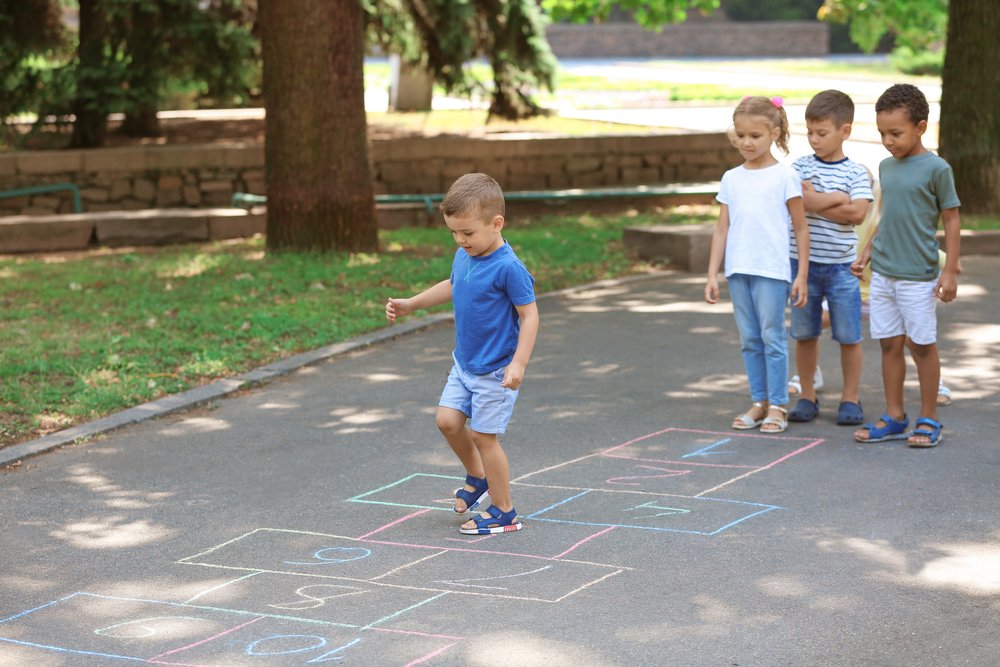Last Updated on January 25, 2024 by Gamesver Team and JC Franco

Hopscotch is considered one of the classical games that both boys and girls can engage in. The game involves simple squares drawn or highlighted on the ground that kids hop on and a small marker to throw on the squares. The game has its origins in ancient Rome around three millennia ago.
The original version of the Hopscotch was an exercise that the Roman soldiers used to learn their footwork. The soldiers would run through the squares in full armor, and the kids made their own adaptations and added a scoring aspect to it, and soon it spread. Is this game beneficial for kids of this era? Let’s find out.
These are 13 reasons why your kids should play Hopscotch:
1. Easy to Begin
To begin playing, all you need is chalk or masking tape depending on whether the kids are playing indoors or outdoors and a marker to throw. This is a great thing, especially because there are those kids that can’t afford costly games. Hopscotch is a free-style game that you can draw, and children enjoy at no cost.
2. Solitary or Multiple Players
Hopscotch can be played by a single person or multiple people. Having player options is an advantage because there are kids that prefer to be on their own, and there are social butterflies, and you can choose the number of players depending on your child’s personality.
The diversity in players is also an essential aspect because of the current social-distancing principles that have been set up during recent times.
3. Play both Indoors and Outdoors
You don’t have to worry about a rainy or cold day with this game; you can play this game both indoors and outdoors. Because the game just requires chalk to begin, you can easily migrate the kids in case of terrible weather. For indoors, using masking tape can make it a semi-permanent gaming solution.
Inside play is ideal for kids who, for some reason, can’t play outside, especially those with medical complications and those that live in places with small spaces like high-rises. They can still enjoy playing classic games indoors.
4. Problem Solving and Critical Thinking
Hopscotch requires brainpower. First, a player needs to decide a few things, like how far to throw the marker and where to jump. They have to decide which foot to land with and count the squares as they hop. When do they get to turn around? Do they need to skip any squares on their way to the destination and back?
All these decisions train your kids’ brains and enable them to think on their feet. It’s also a fantastic way to develop your child’s critical thinking and problem-solving skills in a safe yet unstructured environment.
5. Excellent for Balance and Strength Training
Hopscotch is a traditionally fun way for kids to master body control. With this game, a child has to balance and hop on one leg, jump around, and be able to swap the hopping leg as they play. This requires mastery of the body and is a great way to build core and general strength.
The game also builds body rhythm; how quickly will they need to hop? When will they swap their feet? Hopscotch requires rhythmic finesse that can only be developed by continuous playing.

6. Fun Way for Kids to Keep Fit
Hopscotch requires a lot of body movement, including jumping, hopping, bending over, and coming up again. Kids are required to kick the puck with enough strength to get to the correct square at times. These movements are not only beneficial to their cardio strength but are also a fun way for kids to exercise without feeling pressured.
Because kids spend so much time indoors, we are starting to see an increase in cases of overweight and obese children, and games such as Hopscotch are a great way to make movement fun and exciting.
7. Visual-Motor Coordination
Hopscotch requires a lot of precise movement. For example, one of the rules of the game restricts players from stepping on the square boundaries. The marker has to be thrown on a precise square, and you have to know which square you’re hopping to and which one to skip.
All these require an excellent translation of what the eye sees, how the brain interprets it and how the limbs react. Practice makes perfect; the more your kid plays, the more their visual-motor skills are developed.
8. Mathematical Skills
Hopscotch involves a bit of Math. First, the squares are usually numbered depending on the grid size. The kids have to learn to calculate how many squares they have to skip to get to where the marker is. The numbers can begin from the basic and continue advancing to 25 as the kids grow.
Playing can also be a great way to teach kids different number variations, such as having them jump on even numbers, odd numbers, prime numbers in that order. You can also make it more interesting by adding basic arithmetic lessons such as addition and subtraction.
9. Phonemic Skill Development
The most popular hopscotch game involves drawing numbers in the squares; what if we change things a bit and include words? Phonemic skill development consists of helping your child connect certain sounds with letters. Include the alphabet letters in your game and mention a word, have your child map up the letters that form the word and sound them out as they go along.
This way of learning also boosts their memory, and we are banking on the kids remembering things they learned in a relaxed environment.
10. Keep Them Interested With Different Variants
Kids get bored so quickly, and it’s essential to change things up once in a while to keep them interested. The game has so many variations, and the good thing is you can get creative and make your own adaptations depending on the lesson you want them to learn.
You can turn it into a word game, a numbers game, make it timed, or a category naming game. Changing these up every time kids play makes them feel like they are playing a new game, and they get to traverse different forms of learning.
11. Social Awareness Development
As you know, Hopscotch can either be played by a single child or multiple children. In the case of multiple children playing, the kids have to learn how to take turns and not hog the game. They also have to learn how to win and lose gracefully and proper communication etiquette when speaking to other players.
Also, kids have to cooperate with their team members and learn how to be considerate to the kids who lose the game and explain the rules adequately to be on the same page. All these interactions help kids develop social skills that will help them during the game, and they can be used even in the future.
12. Develops Discipline
Games come with rules to help standardize the competition. Hopscotch has basic rules such as:
- Only one player can go at a time.
- Touching the square lines eliminates the player.
- The overall winner is the first player to complete all the courses.
Several variations require special attention; an example is the timed hopscotch game that requires the player to complete the game within a set time limit. All these are things kids consider so that they aren’t eliminated from the competition and ensure they complete all the courses first. This helps them know the importance of following rules, which then improves their discipline.

13. Distract Kids from Screen Time
Video games are easily accessible these days, and this has turned kids into hermits. They spend all their time indoors, seated and glued to their screens. These kids need to be let out into the sun once in a while. Managing kids’ addiction to their devices is a crucial consideration for parents as this also stunts their social skill development.
Kids are growing up more antisocial every day, and this is because the only interaction they know is through their video games and digital gadgets. Varying hopscotch versions can distract kids from their screens at least for an hour; enough time for them to exercise, learn, catch some sun and interact with their peers.
Final Thoughts
Classical games are making a comeback mostly because they are calorie burners. They are becoming popular with parents, especially because kids get to exercise and, in a small way, get fit while having fun. These games mainly cost close to nothing, and they are also as effective as any character development class.
Kids are going back to playgrounds and are learning how to interact with each other, participating in healthy competitions all while skipping, jumping, and jogging. These games are also perfect because parents and teachers alike can introduce a learning aspect to them. Kids are learning arithmetic and developing their vocabulary.
Do you have kids? Are you a teacher? Hopscotch is the perfect household activity for your kids’ daily routine.

